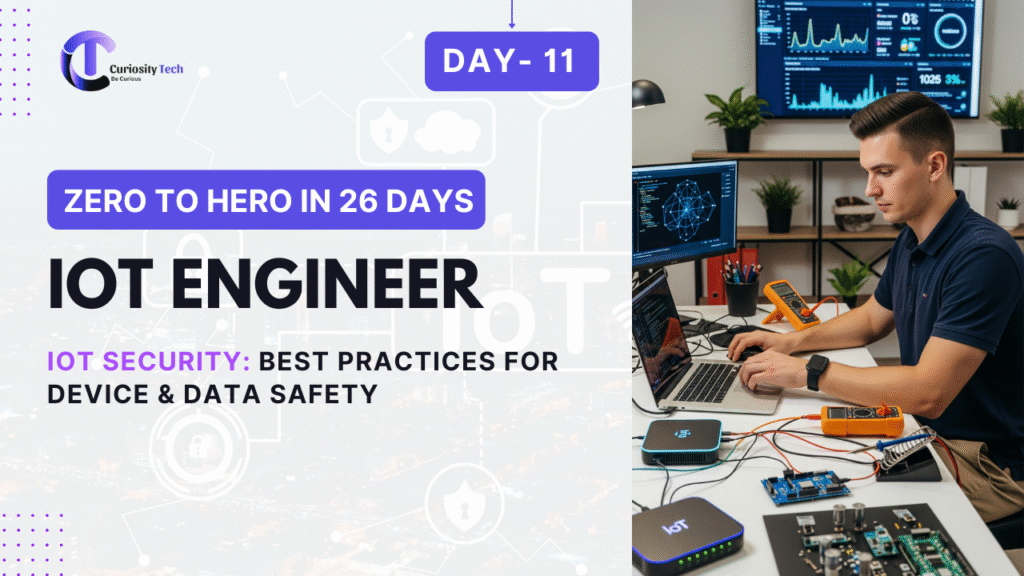Handbook Abstract
By 2025, IoT devices have become prime attack vectors for hackers. Whether it’s a smart home camera being hijacked for surveillance, a factory sensor leaking sensitive production data, or a pacemaker vulnerable to remote exploitation — IoT security is no longer optional, it’s mandatory. This handbook serves as a field-ready guide for IoT engineers to design, deploy, and maintain secure IoT ecosystems.
At CuriosityTech.in Nagpur, one motto is repeated in every IoT bootcamp: “An insecure IoT system is worse than no IoT system at all.”
Threat Landscape in IoT (2025)
IoT threats evolve constantly, but the most common categories include:
- Device Hijacking – Malware installs on IoT cameras, routers, or gateways to form botnets (e.g., Mirai botnet).
- Data Interception – Man-in-the-middle attacks stealing sensor data.
- Firmware Exploits – Outdated firmware with vulnerabilities exploited by attackers.
- Unauthorized Access – Weak or default passwords on IoT dashboards.
- Physical Tampering – Attackers opening IoT devices, replacing chips, or injecting malicious firmware.
Layered Defense Framework (The “IoT Security Onion”)
Think of IoT security like an onion with protective layers:
- Device Layer Security
- Secure boot processes.
- Unique device identifiers.
- No default hard-coded credentials.
- Network Layer Security
- Encrypted transmission (TLS/DTLS).
- Firewalls for IoT gateways.
- VPN tunnels for industrial deployments.
- Application & Data Security
- Strong API authentication and authorization.
- Data encryption at rest in cloud databases.
- Secure dashboard login with MFA.
- Cloud & Edge Security
- Role-based access in AWS, Azure, or Google IoT platforms.
- Monitoring for anomalies (e.g., unusual traffic bursts).
- Edge device hardening (disable unnecessary ports, patch OS).
Best Practices Checklist
Device Security
- ✅ Implement secure boot and encrypted firmware.
- ✅ Force per-device unique certificates.
- ✅ Disable debugging interfaces (UART/JTAG) in production.
Data Transmission Security
- ✅ Always use MQTT over TLS, never plain MQTT.
- ✅ Implement mutual authentication (both device & server verify each other).
- ✅ Rotate encryption keys regularly.
Cloud & Storage Security
- ✅ Encrypt sensitive IoT data at rest using AES-256.
- ✅ Apply token-based API requests.
- ✅ Monitor for suspicious cloud activity using built-in alerting.
Operational Security
- ✅ Patch management system for IoT firmware updates (OTA).
- ✅ Enable audit logs for compliance.
- ✅ Train teams on incident response workflow.
Case Study 1: Smart Camera Breach
Incident: Millions of unsecured CCTV cameras worldwide were hijacked and became part of the Mirai botnet.
Cause: Default admin passwords remained unchanged.
Lesson: Always enforce unique, secure credentials and force updates at first boot.
Case Study 2: Smart Healthcare Wearable Attack
Incident: A hospital in the US faced breaches when fitness trackers connected to patient apps transmitted unencrypted data.
Cause: HTTP instead of HTTPS/TLS; lack of API authentication.
Lesson: Data in healthcare IoT must be encrypted end-to-end to comply with HIPAA/GDPR.
Case Study 3: Industrial IoT Plant Malfunction (Simulated at CuriosityTech Labs)
Scenario: Trainee engineers simulated an attack on factory vibration sensors controlling motors. Attackers flooded MQTT broker with false data (MQTT flooding).
Mitigation Applied:
- Setup broker authentication.
- Implemented rate-limiting on messages.
- Configured anomaly detection to spot unusual traffic burst.
Result: Security restored, demonstrating importance of MQTT hardening.
Key Security Tools and Frameworks (2025)
- AWS IoT Device Defender – Security audits, alerts, network monitoring.
- Azure Security Center for IoT – Threat intelligence, policy checks.
- Google IoT IAM + Shielded VM – Access controls & runtime protections.
- EdgeX Foundry Security Services – Edge-specific APIs for secure device management.
Diagram: IoT Threat Vectors (Conceptual Description)
Picture IoT ecosystem layers (Device → Network → Cloud → App). Threat vectors point inward from all sides:
- Red arrows at Device = malware injection, physical tampering.
- Red arrows at Network = man-in-the-middle, packet sniffing.
- Red arrows at Cloud = API hacks, database breaches.
- Red arrows at Apps = weak login, phishing dashboards.
This visual onion demonstrates that every layer of IoT can, and will, be attacked.
Training Engineers for IoT Security
At CuriosityTech.in Nagpur, IoT engineers undergo hands-on labs like:
- Ethical hacking exercises – breaking into an unsecured ESP32 MQTT connection.
- Secure by design workshop – implementing TLS, OTA patching, and token-based APIs.
- Incident response drills – simulating cyber threats in industrial settings.
True IoT expertise in 2025 is about building systems that assume attack will happen — and are engineered to defend, detect, and recover quickly.

Conclusion
In IoT, “connectivity without security” is a recipe for disaster. With the rising number of connected devices in 2025, IoT engineers must adopt secure-by-design principles: hardened devices, encrypted transmissions, layered defenses, and continuous monitoring. Security is not a one-time setting but an ongoing discipline of vigilance and adaptation.


